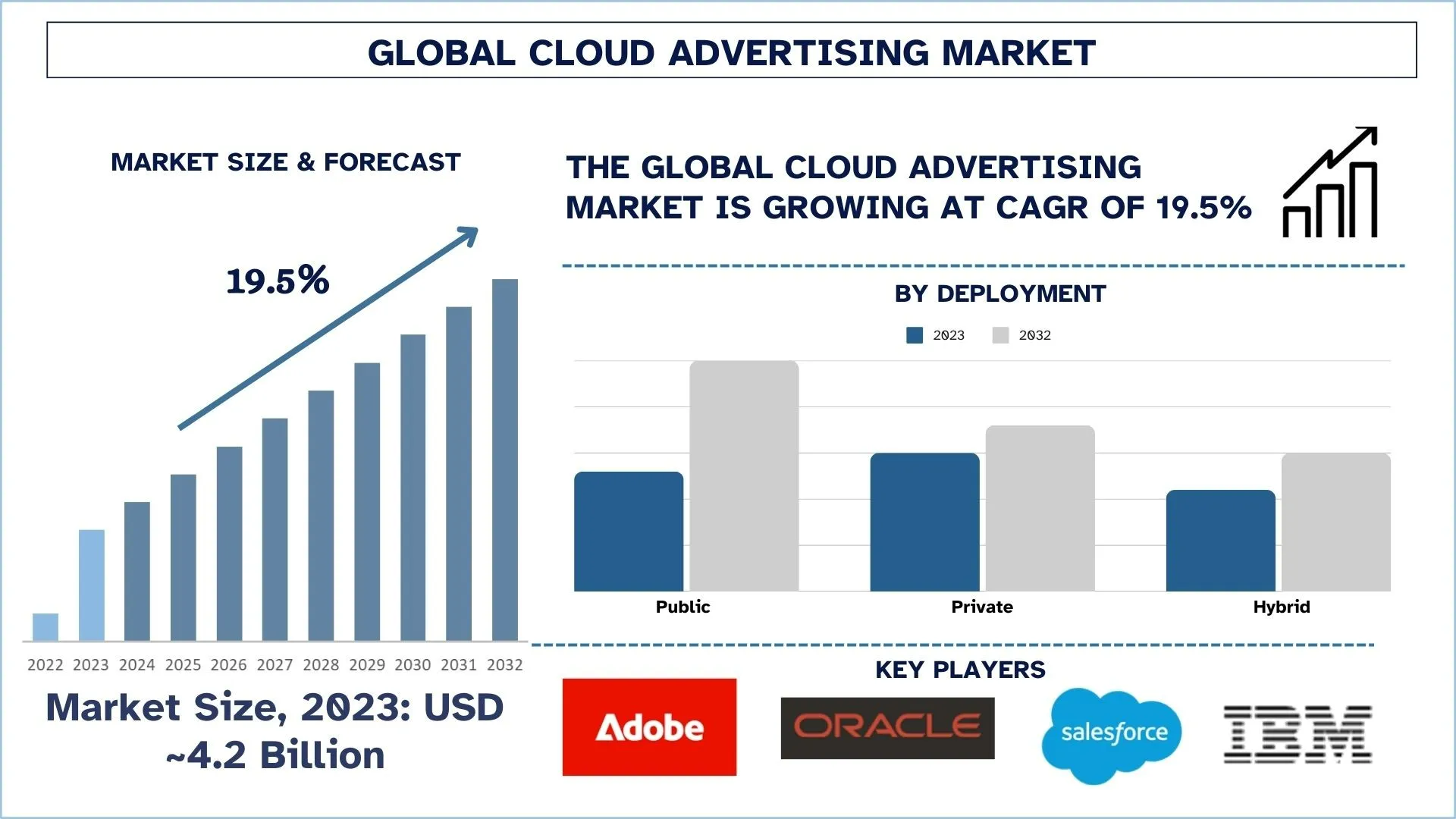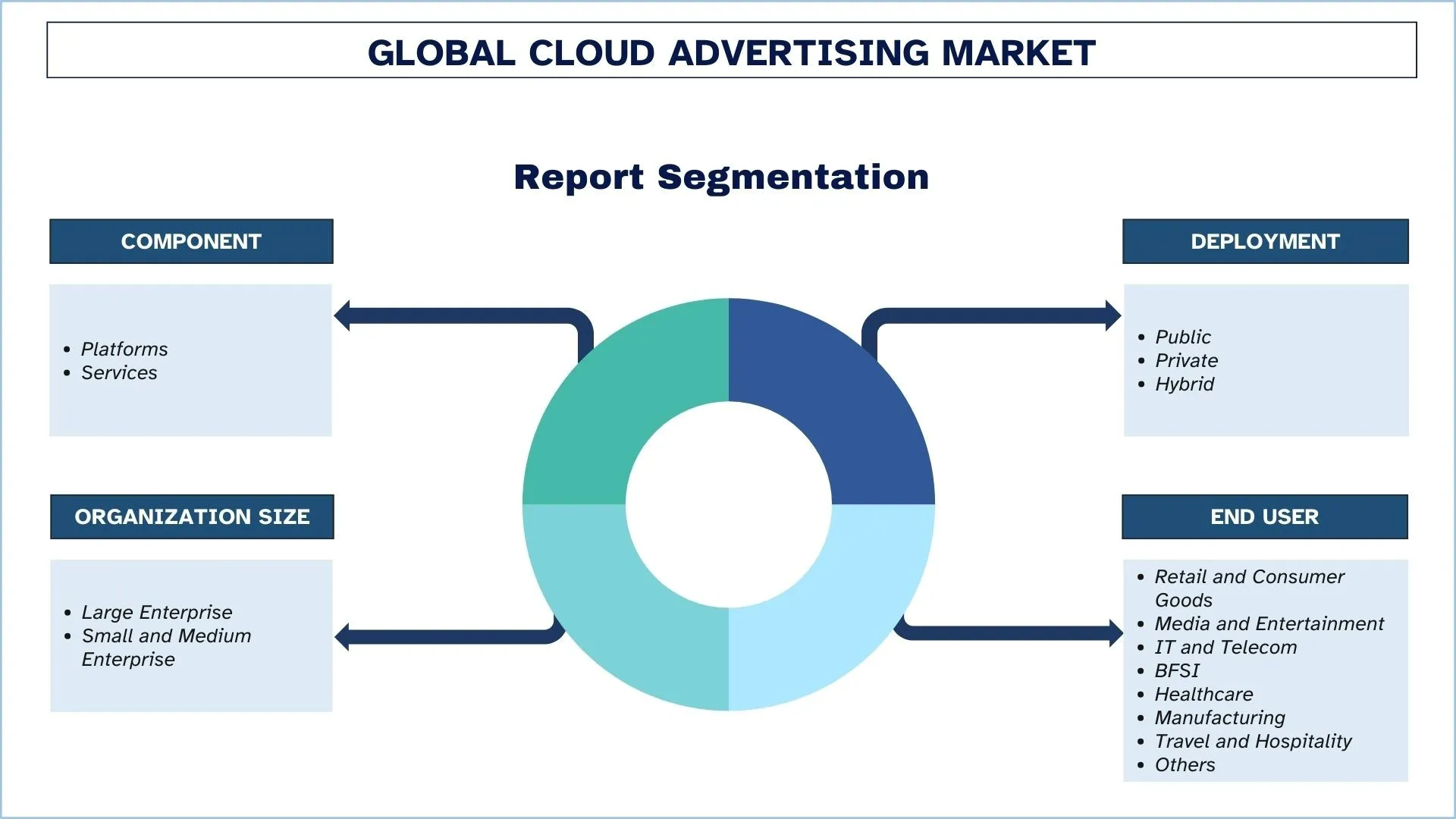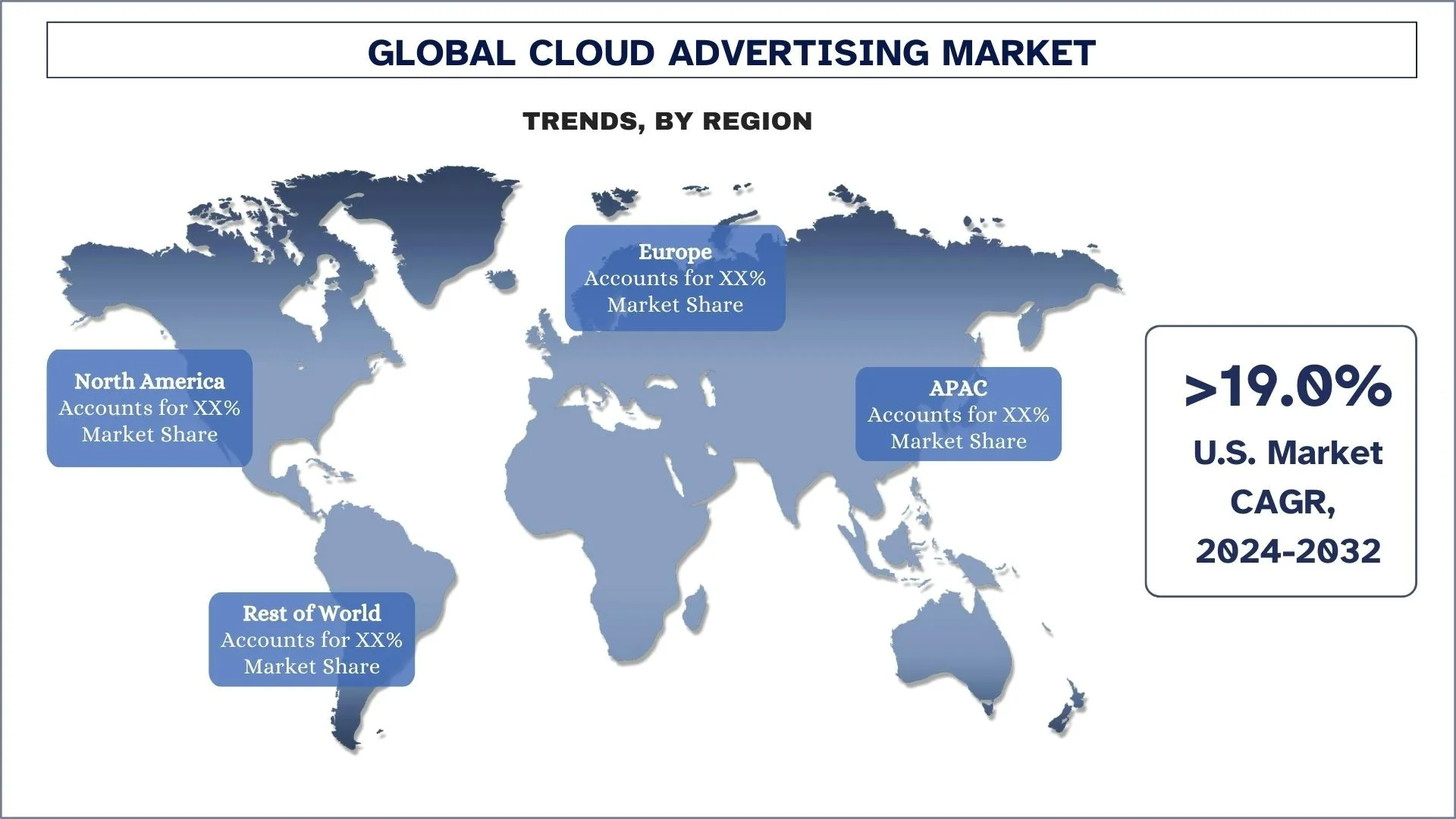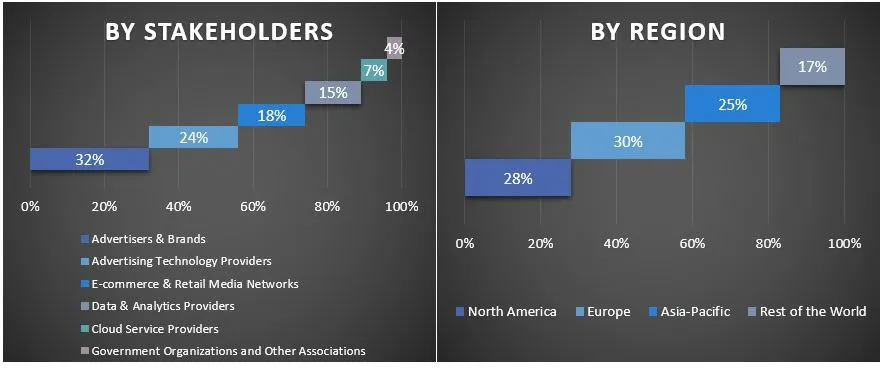- Home
- About Us
- Industry
- Services
- Reading
- Contact Us
Cloud Advertising Market: Current Analysis and Forecast (2024-2032)
Emphasis on Component (Platforms, Services); Deployment (Public, Private, Hybrid); Organization Size (Large Enterprise, Small and Medium Enterprise); End User (Retail and Consumer Goods, Media and Entertainment, IT and Telecom, BFSI, Healthcare, Manufacturing, Travel and Hospitality, and Others); and Region/Country

Cloud Advertising Market Size & Forecast
The Cloud Advertising market was valued at approximately USD 4.2 Billion in 2023 and is expected to grow at a substantial CAGR of around 19.5% during the forecast period (2024-2032) owing to the expansion of e-commerce & retail media networks.
Cloud Advertising Market Analysis
Cloud Advertising is a form of media and communication processes that involve the use of the cloud technologies to design, deploy, and monitor advertisements across the Web, social networks, and applications. It employs AI, data analysis, and machine learning in real-time targeting, communication, and programmatic ad purchase to enhance the ad effectiveness and the return that is on investment.
In order to reach the level of growth and innovation in cloud advertising, adopting AI based applications for data analysis and mechanism of campaign are becoming common among companies. In order to improve customer awareness, companies are coupling the cloud solutions with customer relationship management (CRM) systems. Further, the organizations are also using the Hybrid cloud solutions for achieving the benefits related to the security compliance along with the flexibility of scaling up. This awareness has led to the increased use of an omnichannel approach as a new trend to strengthen the approaches to advertising across many channels.
For instance, on September 23, 2024, Quad/Graphics, Inc. (NYSE: QUAD), a global marketing experience company, announced a collaboration with Google Cloud to leverage its cloud services in the development of a data, creative and personalization powerhouse. Quad’s leading-edge solutions are designed to give advertisers and marketers exceptional accuracy, transparency and cost-efficiency in making direct connections – on-line and off-line – with their customers.
On August 28, 2023, IBM (NYSE: IBM) launched the first ad campaign to formally introduce watsonx, the company's next generation enterprise-focused artificial intelligence and data platform. Global business leaders remain unclear about the real, transformative power of AI and how to leverage it. The campaign is designed to define and differentiate watsonx as a force multiplier that can accelerate impact for global business leaders as they look to apply AI solutions in new and innovative ways.

Cloud Advertising Market Trends
This section discusses the key market trends influencing the various segments of the cloud advertising market as identified by our research experts.
Metaverse & AR/VR Advertising Expansion Transforms Cloud Advertising Industry
The cases of Metaverse and AR/VR in the cloud advertising market are revolutionizing digital marketing since people can interact with advertisements in an engaging way. Data processing, personalization, 3D content delivery in virtual environments are facilitated through cloud technologies. Brands consider these new kinds of advertisements as effective tools for engaging their target audiences and inform them through virtual try-ons, narrative advertising, and brand-owned metaverse locations. This fact leads to a better understanding of the customer base, increased chances for conversion and loyalty, and new possibilities for advertisers’ revenues.
On October 2, 2022, Bharti Airtel unveiled India’s first immersive Virtual Reality (VR) advertisement powered by 5G. The advertisement format on the Airtel Thanks app opens new avenues for brands to engage with consumers in an immersive environment that was previously not possible in the traditional advertising paradigm.
North America leads the market.
Cloud advertising in North America obtains its growth from the growing need for customized and data-focused marketing. This region has favorable technological human capital and high levels of digitalization, which solidify the progress to industrialized platforms in the cloud. Cloud advertising enables firms to use AI for timely targeting and performance analysis in diverse media platforms. Cloud advertising platforms also integrate well with other customer relationship management systems commonly referred to as CRM. This makes targeting much more effective and reaches a variety of customer segments and thus creates higher returns on investment and the base for markets to grow.
On October 14, 2024, Adobe announced the general availability of Adobe GenStudio for Performance Marketing, a new generative AI-first application that empowers brands and agencies to accelerate the delivery of global advertising and marketing campaigns. The new offering addresses one of the biggest challenges facing businesses today, where the need for highly personalized, on-brand and performant content—across a myriad of channels and geographies—is outstripping available resources.

Cloud Advertising Industry Overview
The Cloud Advertising market is competitive, with several global and international players. The key players are adopting different growth strategies to enhance their market presence, such as partnerships, agreements, collaborations, new product launches, geographical expansions, and mergers and acquisitions. Some of the major players operating in the market are Adobe, SAP SE, Salesforce, Inc., Google, IBM, Amazon, Microsoft, The Nielsen Company (US), LLC., Mediaocean, Wipro.
Cloud Advertising Market News
- On January 9, 2024, GroupM, WPP’s media investment group, announced a collaboration between GroupM Nexus, the industry-leading performance marketing organization and Amazon Ads, to co-develop and launch the Amazon Marketing Cloud Maturity Framework. Available to GroupM clients, the custom offering will rigorously assess marketers’ maturity level with Amazon Marketing Cloud to align their business needs with the most suitable Amazon Marketing Cloud solutions.
- On January 21, 2025, Audiencerate, an innovative technology company, leader in the development of advanced solutions for digital marketing (MarTech) and online advertising (AdTech) announced that it has signed a partnership agreement with V-Valley, a company of the Esprinet Group focused on the distribution of Advanced Solutions. Thanks to its partnership with Microsoft, Audiencerate is at the forefront of integrating artificial intelligence and cloud computing to optimize marketing and advertising strategies. This strategic agreement between V-Valley and Audiencerate aims to support SMEs in the process of digitalization and innovation, facilitating access to advanced technologies and contributing to their digital transformation by providing the necessary tools to compete in an increasingly data-driven market.
- On January 20, 2025, Bharti Airtel, one of India’s largest telecom services providers and Bajaj Finance, the country’s largest private-sector Non-Banking Financial Company (NBFC), announced a strategic partnership to create one of India’s largest digital platforms for financial services and transform last mile delivery. The one-of-a-kind partnership brings together Airtel’s highly engaged customer base of 375 million, 12 lakh+ strong distribution network, and Bajaj Finance’s diversified suite of 27 product lines, and distribution heft of 5,000+ branches and 70,000 field agents.
Cloud Advertising Market Report Coverage
Report Attribute | Details |
Base year | 2023 |
Forecast period | 2024-2032 |
Growth momentum | Accelerate at a CAGR of 19.5% |
Market size 2023 | USD 4.2 Billion |
Regional analysis | North America, Europe, Asia-Pacific, Rest of the World |
Major contributing region | Asia-Pacific is expected to grow at the highest CAGR during the forecasted period. |
Key countries covered | U.S., Canada, Germany, France, UK, Spain, Italy, China, Japan, and India |
Companies Profiled | Adobe, SAP SE, Salesforce, Inc., Google, IBM, Amazon, Microsoft, The Nielsen Company (US), LLC., Mediaocean, Wipro |
Report Scope | Market Trends, Drivers, and Restraints; Revenue Estimation and Forecast; Segmentation Analysis; Demand and Supply Side Analysis; Competitive Landscape; Company Profiling |
By Component, By Deployment, By Organization Size, By End user, By Region/Country |
Reasons to buy this report:
- The study includes market sizing and forecasting analysis validated by authenticated key industry experts.
- The report presents a quick review of overall industry performance at one glance.
- The report covers an in-depth analysis of prominent industry peers with a primary focus on key business financials, product portfolios, expansion strategies, and recent developments.
- Detailed examination of drivers, restraints, key trends, and opportunities prevailing in the industry.
- The study comprehensively covers the market across different segments.
- Deep dive regional level analysis of the industry.
Customization Options:
The global Cloud Advertising market can be customized further as per the requirement or any other market segment. Besides this, UMI understands that you may have your own business needs, hence feel free to connect with us to get a report that completely suits your requirements.
Table of Content
Research Methodology for the Cloud Advertising Market Analysis (2022-2032)
Analyzing the historical market, estimating the current market, and forecasting the future market of the global Cloud Advertising market were the three major steps undertaken to create and analyze the adoption of Cloud Advertising in major regions globally. Exhaustive secondary research was conducted to collect the historical market numbers and estimate the current market size. Secondly, to validate these insights, numerous findings and assumptions were taken into consideration. Moreover, exhaustive primary interviews were also conducted, with industry experts across the value chain of the global Cloud Advertising market. Post assumption and validation of market numbers through primary interviews, we employed a top-down/bottom-up approach to forecasting the complete market size. Thereafter, market breakdown and data triangulation methods were adopted to estimate and analyze the market size of segments and sub-segments of the industry. Detailed methodology is explained below:
Analysis of Historical Market Size
Step 1: In-Depth Study of Secondary Sources:
A detailed secondary study was conducted to obtain the historical market size of the Cloud Advertising market through company internal sources such as annual reports & financial statements, performance presentations, press releases, etc., and external sources including journals, news & articles, government publications, competitor publications, sector reports, third-party database, and other credible publications.
Step 2: Market Segmentation:
After obtaining the historical market size of the Cloud Advertising market, we conducted a detailed secondary analysis to gather historical market insights and share for different segments & sub-segments for major regions. Major segments are included in the report as component, deployment, organization size, end user, and regions. Further country-level analyses were conducted to evaluate the overall adoption of testing models in that region.
Step 3: Factor Analysis:
After acquiring the historical market size of different segments and sub-segments, we conducted a detailed factor analysis to estimate the current market size of the Cloud Advertising market. Further, we conducted factor analysis using dependent and independent variables such as component, Deployment, Organization Size, End user, and regions of the Cloud Advertising market. A thorough analysis was conducted for demand and supply-side scenarios considering top partnerships, mergers and acquisitions, business expansion, and product launches in the Cloud Advertising market sector across the globe.
Current Market Size Estimate & Forecast
Current Market Sizing: Based on actionable insights from the above 3 steps, we arrived at the current market size, key players in the global Cloud Advertising market, and market shares of the segments. All the required percentage shares split and market breakdowns were determined using the above-mentioned secondary approach and were verified through primary interviews.
Estimation & Forecasting: For market estimation and forecast, weights were assigned to different factors including drivers & trends, restraints, and opportunities available for the stakeholders. After analyzing these factors, relevant forecasting techniques i.e., the top-down/bottom-up approach were applied to arrive at the market forecast for 2032 for different segments and sub-segments across the major markets globally. The research methodology adopted to estimate the market size encompasses:
- The industry’s market size, in terms of revenue (USD) and the adoption rate of the Cloud Advertising market across the major markets domestically
- All percentage shares, splits, and breakdowns of market segments and sub-segments
- Key players in the global Cloud Advertising market in terms of products offered. Also, the growth strategies adopted by these players to compete in the fast-growing market
Market Size and Share Validation
Primary Research: In-depth interviews were conducted with the Key Opinion Leaders (KOLs) including Top Level Executives (CXO/VPs, Sales Head, Marketing Head, Operational Head, Regional Head, Country Head, etc.) across major regions. Primary research findings were then summarized, and statistical analysis was performed to prove the stated hypothesis. Inputs from primary research were consolidated with secondary findings, hence turning information into actionable insights.
Split of Primary Participants in Different Regions

Market Engineering
The data triangulation technique was employed to complete the overall market estimation and to arrive at precise statistical numbers for each segment and sub-segment of the global Cloud Advertising market. Data was split into several segments and sub-segments after studying various parameters and trends in the component, deployment, organization size, end user, and regions of the global Cloud Advertising market.
The main objective of the Global Cloud Advertising Market Study
The current & future market trends of the global Cloud Advertising market were pinpointed in the study. Investors can gain strategic insights to base their discretion for investments on the qualitative and quantitative analysis performed in the study. Current and future market trends determined the overall attractiveness of the market at a regional level, providing a platform for the industrial participant to exploit the untapped market to benefit from a first-mover advantage. Other quantitative goals of the studies include:
- Analyze the current and forecast market size of the Cloud Advertising market in terms of value (USD). Also, analyze the current and forecast market size of different segments and sub-segments.
- Segments in the study include areas of component, deployment, organization size, and end user, and regions.
- Define and analyze the regulatory framework for the Cloud Advertising
- Analyze the value chain involved with the presence of various intermediaries, along with analyzing customer and competitor behaviors of the industry.
- Analyze the current and forecast market size of the Cloud Advertising market for the major region.
- Major countries of regions studied in the report include Asia Pacific, Europe, North America, and the Rest of the World
- Company profiles of the Cloud Advertising market and the growth strategies adopted by the market players to sustain the fast-growing market.
- Deep dive regional level analysis of the industry
Frequently Asked Questions FAQs
Q1: What is the cloud advertising market's current size and growth potential?
The cloud advertising market was valued at USD 4.2 Billion in 2023 and is expected to grow at a CAGR of 19.5% during the forecast period (2024-2032).
Q2: What are the driving factors for the growth of the cloud advertising market?
The rising adoption of AI & machine learning, growing digital advertising spend, rising demand for customer-centric advertising, increasing mobile & social media usage, expansion of e-commerce & retail media networks the cloud advertising market.
Q3: Which segment has the largest share of the cloud advertising market by deployment?
Hybrid has the largest share of the cloud advertising market by deployment.
Q4: What are the major trends in the cloud advertising market?
The AI & automation in Ad campaigns is the major trend in the cloud advertising market.
Q5: Which region will dominate the cloud advertising market?
North America dominated the market in 2023.
Related Reports
Customers who bought this item also bought










